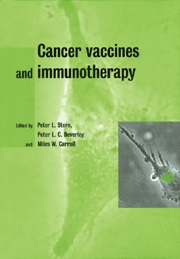Book contents
- Frontmatter
- Contents
- List of contributors
- 1 Immunity and cancer
- 2 Immunotherapy of bladder cancer
- 3 Poxviruses as vectors for cancer immunotherapy
- 4 Vaccinia-based human papillomavirus vaccines in cervical cancer
- 5 Vaccine delivery and immunosuppression in cervical cancer
- 6 Vaccines for colon cancer
- 7 MUC1 vaccines and breast cancer
- 8 Anti-idiotypic vaccination
- 9 Immunotherapy and vaccination against Epstein–Barr virus-associated cancer
- 10 Serologically identified tumour antigens as cancer vaccines
- 11 CTL-defined cancer vaccines in melanoma and other epithelial cancers
- 12 DNA vaccines against B-cell tumours
- 13 Dendritic cell approaches to immunotherapy
- 14 Overview
- 15 Recent developments
- Index
8 - Anti-idiotypic vaccination
Published online by Cambridge University Press: 06 January 2010
- Frontmatter
- Contents
- List of contributors
- 1 Immunity and cancer
- 2 Immunotherapy of bladder cancer
- 3 Poxviruses as vectors for cancer immunotherapy
- 4 Vaccinia-based human papillomavirus vaccines in cervical cancer
- 5 Vaccine delivery and immunosuppression in cervical cancer
- 6 Vaccines for colon cancer
- 7 MUC1 vaccines and breast cancer
- 8 Anti-idiotypic vaccination
- 9 Immunotherapy and vaccination against Epstein–Barr virus-associated cancer
- 10 Serologically identified tumour antigens as cancer vaccines
- 11 CTL-defined cancer vaccines in melanoma and other epithelial cancers
- 12 DNA vaccines against B-cell tumours
- 13 Dendritic cell approaches to immunotherapy
- 14 Overview
- 15 Recent developments
- Index
Summary
Introduction
The ideal cancer vaccine should stimulate cytotoxic T cells (CTL), helper T cells and antibodies. The CTLs will efficiently kill all tumour cells expressing target antigen and MHC. Helper T cells will help in the production of CTLs but will also migrate to tissues expressing the target antigen. Once they have localized within the tissues they will release the cytotoxic cytokines (TNFβ, IFN γ) and recruit nonspecific effector cells such as macrophages. Both of these cytotoxic effects will result in tumour cell death of antigen positive or negative cells. They are therefore synergistic with CTL killing. T helper cells can also recruit natural killer (NK) cells that will kill any tumour cells that have lost MHC expression. As this is a common mechanism for tumours to evade CTL killing it is an important component of any immune response induced by a cancer vaccine. The potential of antibody responses to contribute to antitumour effects is less clear. The ‘type 1’ T cells that help in the activation of CTLs can also help in the production of specific subclasses of antibodies (IgG2a in mice and IgG1 in humans). These antibodies will kill any tumour cell expressing target antigen by antibody-dependent cellular cytotoxicity that is mediated by Fc receptor expressing leucocytes, including NK cells. T helper cell recruitment of NK cells into tumour tissues is therefore also essential for antibodymediated tumour killing.
- Type
- Chapter
- Information
- Cancer Vaccines and Immunotherapy , pp. 162 - 173Publisher: Cambridge University PressPrint publication year: 2000



